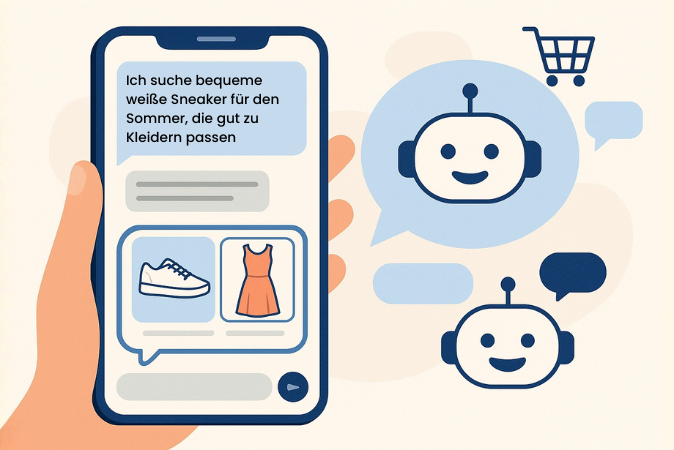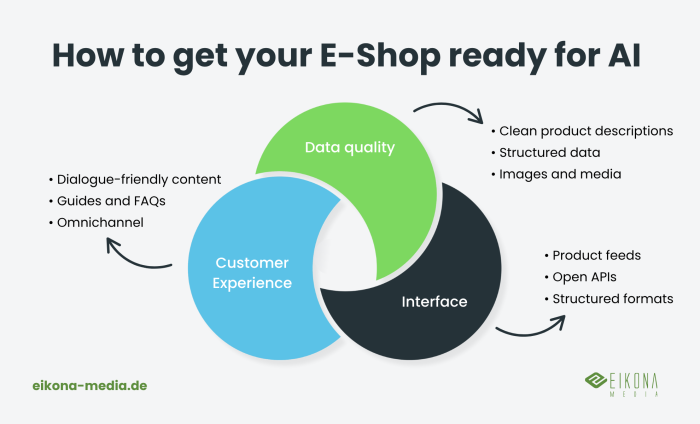ChatGPT Shopping: How AI is changing online shopping and how you can get your store ready for it

ChatGPT Shopping is revolutionizing e-commerce: in the future, customers will find products through dialogue rather than clicks. Discover why AI shopping is a game changer and how you can optimally prepare your online store for it - from data quality to social media monitoring.
Welcome to the world of AI shopping
Imagine if your customers no longer had to type in search terms, click through filters, or scroll through endless product lists. Instead, they simply ask a question and an AI like ChatGPT directly provides them with the right products, tips, and inspiration. This is already working in appropriately prepared online stores and with ChatGPT: Welcome to the world of AI shopping.
In this article, you will learn:
- What ChatGPT Shopping is and why it could be a real game changer in e-commerce.
- What opportunities AI opens up for online retail.
- How you can prepare your online shop for ChatGPT Shopping.
- And what is not allowed in ChatGPT – so you know how secure the whole thing is.
What is ChatGPT Shopping?
You probably already know ChatGPT as a tool that writes texts, answers questions, or even generates code. But the next stage of development is to map online shopping directly via AI dialogues.
This means that in the future, customers will be able to ask ChatGPT about products and the AI will display suitable items directly in the chat. This combines classic browsing with a personal shopping advisor who is available 24/7.
An example:
- Instead of typing “women's sneakers size 39 white” into the search field, the customer writes:
“I'm looking for comfortable white sneakers for the summer that go well with dresses.” - ChatGPT understands the request, compares it with shop data, and suggests products that really fit.
This is not only more convenient, but also much closer to real purchasing advice, which is otherwise found in brick-and-mortar stores. You get suggestions that lead you to make a purchase in an online shop. So it's similar to Google Shopping, only with more relevant results.
Why AI is a game changer in e-commerce
E-commerce has developed rapidly over the past 20 years: from static product catalogs to recommendation engines and personalized newsletters. AI shopping is now taking it to a whole new level.
Here are a few reasons why:
1. More convenience
Customers no longer need to know how to search. They simply state their needs and the AI does the rest.
2. More relevant results
Instead of showing generic hit lists, AI can understand the context: budget, style preferences, occasions, or personal preferences. For example, you can also search for cat-proof sofas, and the AI will explain what features they need to have and show you examples with links to online stores.
3. Higher conversion rates
The less friction there is in the purchasing process, the higher the probability that someone will actually place an order. AI shopping shortens the customer journey enormously because customers provide more information about the product they are looking for, allowing more suitable alternatives to be suggested more quickly.
4. Closer to a “real” consultation
Especially in segments where advice is important (e.g., fashion, technology, furniture), AI can make the shopping experience more human, suggest better alternatives, and even guide customers step by step to the product that best suits them.
5. Via ChatGPT, Gemini, or directly in the online store
Of course, customers can start their search in systems such as ChatGPT or Google's Gemini and search across the entire network, so to speak. However, AI search is also possible for your store. The necessary interfaces already exist. At EIKONA Media, for example, we also enable AI search for assets in our digital asset management system TESSA DAM.
Even though AI shopping is still in its infancy, it will quickly gain acceptance in the coming years due to the advantages it offers consumers – much faster than e-commerce did in the past. That's why you should check what needs to be done to get involved in ChatGPT shopping and avoid losing market share in the future.
What is ChatGPT Shopping Instant Checkout?
In fall 2025, ChatGPT introduced new possibilities for users and online stores with Instant Checkout. It is based on the Agentic Commerce Protocol. In the US, it works with Etsy and via Shopify.
Here's how it works:
- ChatGPT displays product recommendations – sorted by relevance; advertising budget does not (yet) play a role.
- If an item supports Instant Checkout, a “Buy” button appears directly in the chat.
- Customers click or tap on “Buy,” confirm shipping and payment details, and the purchase is complete without having to leave the chat.
- Everything runs through the retailer's existing systems: orders, payments, and fulfillment remain in your infrastructure, ChatGPT transfers the information.
For retailers, this means:
- New convenience: Customers can make even more spontaneous purchases, increasing conversion rates.
- No additional costs for buyers: The price remains the same, only the purchasing process becomes easier.
- Commission: Retailers pay as usual in performance marketing. We do not yet know how the cost structure will develop.
Instant Checkout makes ChatGPT Shopping not only a consulting tool, but also a direct sales channel. That is why it is important for retailers to quickly get to grips with AI shopping and Generative Engine Optimization (GEO).
How retailers can benefit from ChatGPT Shopping
ChatGPT Shopping opens up new channels and touchpoints for retailers:
- New visibility: Products can be found directly via AI interfaces without the customer knowing the store beforehand.
- Better customer experience: Your store becomes not just a product catalog, but a source of advice.
- New conversion opportunities: Those who are present at the “formulate needs” interface can engage with customers much earlier.
However, for this to work, retailers must do their homework.
Preparing your online shop: How to get ready for AI shopping
To ensure your online store benefits from AI-powered shopping, you should focus on three areas: data quality, interfaces and customer experience.
1. Optimize product data
AI is only as good as the data it works with. For you, this means:
- Clean product descriptions: Write not only for Google, but also for AI. Clear, detailed descriptions with added value are a must. In the future, you will need to pay more attention to text quality and integrate clear benefits.
- Structured data: Use product attributes such as color, material, size, or areas of application consistently.
- Images and media: The more visual information is available, the better AI can make recommendations. The use of a Digital Asset Management Systems is a good option here.
Tip: Think about what questions customers would ask in the store and answer them directly in your product data, product descriptions, and other texts on the product detail pages.
2. Create interfaces
ChatGPT needs access to your data in order to recommend your products. Feeds and APIs play a major role here:
- Product feeds: Updated data feeds (e.g., as for Google Shopping) form the basis.
- Open APIs: The easier it is to access your product data, the easier it is for AI systems to integrate it.
- Structured formats: JSON-LD, Schema.org, or comparable standards are helpful for making information machine-readable.
3. Rethink customer experience
AI shopping is also changing customer expectations. Your store should respond to this:
- Conversation-friendly content: Provide answers to questions, not just bare product data. Ask yourself what benefits product features bring to the customer.
- Guides and FAQs: Content that advises customers is becoming a gold mine.
- Think omnichannel: Ensure that customers who discover a product via ChatGPT also have a seamless experience in the shop—from the shopping cart to support.
4. Product reviews and social web monitoring
When you consider how AI collects information about the actual use of your products, you will quickly realize that product reviews and discussions on social media play a central role. LLMs not only analyze your official product data, but also draw on reviews, forums, and platforms such as Reddit.
For you, this means:
- Active review management: Collect authentic customer feedback and respond to comments.
- Social listening: Monitor what is being said about your brand and products on social media.
- Proactive optimization: Use the insights gained to continuously improve product quality and service.
It is particularly important for manufacturers to take action here. If you neglect this monitoring, AI systems may convey a distorted image of your products to customers.
What is not permitted on ChatGPT?
When we talk about ChatGPT Shopping, trust plays a major role. Customers need to know that their data is secure and that AI is being used responsibly.
ChatGPT is therefore subject to clear guidelines:
- No sensitive data: Personal information such as credit card details, passwords, or confidential business data may not be processed. Doing so would also violate the GDPR.
- No dangerous content: ChatGPT must not provide illegal, discriminatory, or harmful information.
- No manipulation: Recommendations should be transparent and in the user's best interest—not hidden advertising without labeling.
- Security standards: AI may not generate content that violates applicable law or ethical standards.
- For you as a retailer, this means you can trust that the channel will not become the Wild West, but will remain controlled and in accordance with regulations.
What risks and challenges does AI shopping pose for retailers?
Of course, it's not all sunshine and roses. Retailers also need to be aware of potential stumbling blocks:
- Dependence on platforms: If ChatGPT or other AI tools become central gatekeepers, dependence increases. This is particularly the case if AI product searches become plastered with advertising, as is currently the case with Amazon.
- Data control: What data do you disclose, and how is it used? There are no far-reaching findings on this yet. You should not give AI machines such as ChatGPT more data than is publicly available on your website or that you release for publication in other ways.
- Competitive pressure: Those who do not optimize their product data will become invisible in AI searches. And unlike Amazon, the results list is considerably more focused. Competition for pole position is therefore becoming tougher.
The good news is that retailers who start early can secure a head start by gaining experience and learning how the new dimension of e-commerce works.
Practical tasks for you to do
To help you get started right away, here is a short checklist:
- Clean up product data: Standardize attributes, optimize texts (formulate them in a benefit-oriented way and ensure readability), improve images.
- Create a technical basis: Check feed and API structure.
- Expand content: Incorporate guides, blog posts, FAQs, and videos.
- Be bold: Try out initial tests with chatbots in your shop or integrations via third-party providers.
- Develop a strategy: Consider how AI shopping fits into your long-term e-commerce strategy.
Conclusion
The future of online shopping is dialogue-oriented
ChatGPT Shopping and AI in e-commerce are no longer science fiction—they are on the verge of radically changing online retail. For you as a retailer, this means: act now. Those who invest early in clean data, interfaces, and dialogue-oriented content have the opportunity to be at the forefront.
The key question is no longer if, but when customers will begin their shopping journey with AI. And when they do, your shop should be ready. We at EIKONA Media are happy to help.

